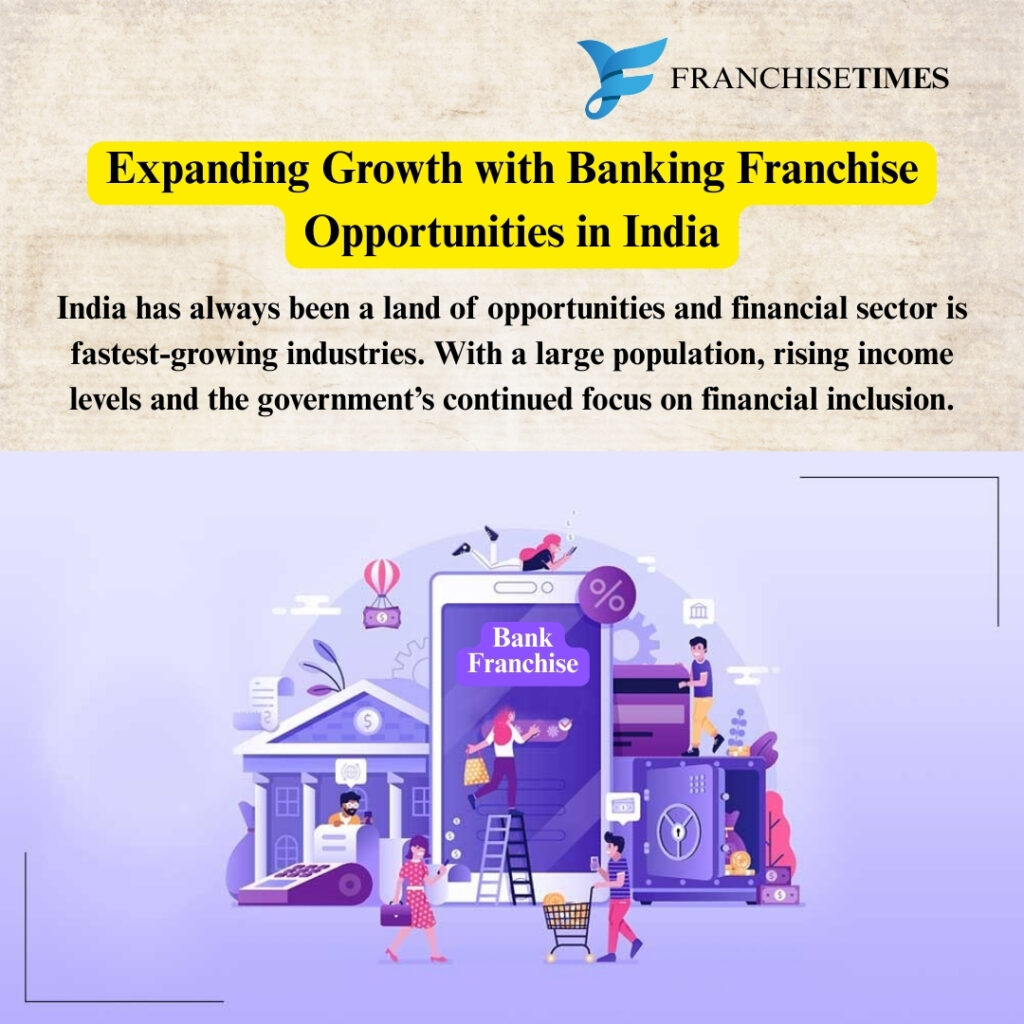Expanding Growth with Banking Franchise Opportunities in India
India has always been a land of opportunities, and its financial sector is one of the fastest-growing industries in the world. With a large population, rising income levels, and the government’s continued focus on financial inclusion, banks have become an essential part of people’s daily lives. However, opening a new bank branch requires huge capital, regulatory approvals, and a long waiting period. For entrepreneurs and investors who wish to enter the financial services sector with less risk and investment, Banking Franchise Opportunities India have emerged as a practical solution.

A banking franchise allows individuals or businesses to partner with leading banks and provide essential banking services to customers. This model benefits both sides: banks expand their reach without heavy infrastructure costs, while franchise owners earn commissions and incentives for facilitating services. As demand for formal financial services continues to rise, this business model is becoming one of the most promising ventures for small and medium entrepreneurs across India.
In this detailed guide, we will explore the growing demand for banking franchises, the different models available, the benefits they bring, the challenges that franchise owners face, and what the future holds for this sector.
Rising Demand for Banking Franchise Opportunities
The Indian economy has seen a rapid transformation in the past two decades. The rise of digital technology, the entry of global investors, and an increase in household incomes have created a strong demand for formal banking. Yet, a significant percentage of India’s population still lacks access to financial services. According to government reports, millions of Indians, especially in rural areas, remain unbanked or underbanked.
This gap has created massive scope for Banking Franchise Opportunities India. Unlike urban centers where banks already have a strong presence, rural and semi-urban regions still rely on limited banking infrastructure. Banks cannot open full-fledged branches everywhere because it requires heavy investment and regulatory approvals. Franchises bridge this gap by acting as local banking touchpoints.
Government schemes such as Pradhan Mantri Jan Dhan Yojana (PMJDY) have already added millions of new bank accounts, but maintaining access in rural areas requires franchise-based outlets like Business Correspondents (BCs) and Customer Service Points (CSPs). Moreover, India’s digital revolution has created additional demand for kiosks, ATMs, and digital banking franchises. With UPI payments, mobile wallets, and Aadhaar-enabled services becoming common, banking franchises have become more relevant than ever before.
Business Models of Banking Franchises in India
Banking is a broad sector, and franchise opportunities come in different formats. Depending on investment capacity, location, and business goals, entrepreneurs can choose from several models. Here are the most prominent ones:
1. Business Correspondent (BC) Model
This is the most popular model for banking franchise opportunities in India. A Business Correspondent works as a representative of a bank and serves customers in areas where branches are not available. They help in opening accounts, handling deposits and withdrawals, processing loans, and enabling government scheme benefits.
Banks prefer this model because it allows them to extend their services without setting up costly branches. Franchise owners, on the other hand, earn commissions for every transaction. In rural areas, this model has proven extremely successful in spreading financial literacy and access.
2. Customer Service Point (CSP) Model
The CSP model functions like a mini-bank branch operated by a franchise partner. Services include cash deposits, withdrawals, fund transfers, Aadhaar linking, passbook printing, and balance inquiries. CSPs are usually set up in small shops, internet cafes, or dedicated outlets with basic infrastructure.
CSPs are ideal for entrepreneurs with limited capital as the initial investment is low compared to setting up other businesses. With growing demand for basic banking services, CSPs have become an essential part of India’s banking ecosystem.
3. ATM Franchise Model
ATMs are one of the most widely used banking facilities, yet many areas still suffer from limited access. Entrepreneurs can invest in an ATM franchise by partnering with leading banks. In this model, the franchise owner is responsible for installation, maintenance, and cash replenishment, while earning revenue through transaction charges paid by the bank.
ATM franchises are profitable in locations with high footfall, such as markets, transport hubs, and residential areas. As cash usage remains high in India despite digital payments, the demand for ATMs continues to grow.
4. Loan and Insurance Franchise Model
Many banks and NBFCs offer franchise models focusing specifically on loans and insurance products. In this format, the franchise partner acts as a sales and distribution channel for financial products such as personal loans, home loans, gold loans, health insurance, and life insurance.
This model requires strong communication and sales skills but offers high earning potential since commissions on loans and insurance are generally higher than basic transaction fees. With rising demand for credit and insurance penetration, this model is expanding rapidly.
5. Digital Banking Kiosk Model
India’s transition to a digital economy has opened new opportunities in kiosk banking. These kiosks offer services such as mobile recharges, utility bill payments, UPI transactions, and digital fund transfers. Low investment, high transaction volume, and increasing customer preference for digital solutions make kiosks highly attractive.
The digital banking kiosk model has grown exponentially with the rise of mobile banking apps and government-backed initiatives like Digital India. For entrepreneurs looking to tap into a tech-driven future, this is a promising format.
Why Entrepreneurs Choose Banking Franchise Opportunities
The growth of banking franchises is not accidental. Entrepreneurs across India are increasingly drawn to this business model for several reasons:
- Low-Risk Investment – Compared to starting an independent financial service business, a banking franchise is relatively safe because it is backed by the trust of established banks.
- Brand Recognition – Customers prefer dealing with well-known banks. As a franchise partner, you don’t need to spend heavily on marketing or brand-building.
- Growing Rural Demand – Rural areas remain underpenetrated, and banks are eager to expand their presence there. Franchise owners benefit from this rising demand.
- Steady Commission-Based Income – Whether it’s account opening, loan disbursement, or ATM transactions, franchise owners earn commissions on services.
- Government Backing – The government promotes financial inclusion, digital payments, and rural credit schemes, which creates a favorable environment for franchise owners.
- Technology Support – Banking franchises receive training, software support, and digital tools from partner banks, reducing operational challenges.
This combination of factors makes banking franchise opportunities in India one of the most secure business ventures for small and medium entrepreneurs.
Challenges in the Banking Franchise Business
Although the opportunity is lucrative, running a banking franchise comes with its own set of challenges. Entrepreneurs should be aware of these before investing:
- Regulatory Compliance – Banking is one of the most regulated industries in India. Franchise owners must follow strict rules laid down by the Reserve Bank of India (RBI) and partner banks.
- Limited Decision-Making Power – Since franchises operate under a bank’s guidelines, owners have less flexibility compared to independent businesses.
- Revenue Fluctuations – Income depends on transaction volumes, which may vary by region. Rural areas might initially see low transaction activity.
- Customer Education – Many customers, especially in rural areas, are new to digital banking. Franchise owners must invest time in educating them.
- Training Needs – Staff require regular training in compliance, customer service, and new digital tools.
Despite these hurdles, most challenges can be overcome with proper planning, location choice, and customer relationship management.
Future of Banking Franchise Opportunities in India
The Indian banking franchise sector is expected to grow significantly in the coming years. Several factors support this growth:
- Expansion of Digital Banking – With the success of UPI and mobile banking apps, digital kiosks and CSPs will see greater demand.
- Financial Inclusion Drive – Government initiatives will continue to push banks into unbanked areas, creating more franchise partnerships.
- Rural Market Penetration – Rural areas remain a goldmine for franchise owners due to rising awareness and demand for credit and savings products.
- ATM Growth – Cash transactions remain strong in India, ensuring continued demand for ATM franchises.
- Partnership with Fintechs – Banks collaborating with fintech startups will lead to innovative hybrid franchise models.
Overall, the sector’s future looks bright. Entrepreneurs entering now stand to gain first-mover advantages as competition increases in the coming years.
Conclusion
The Indian banking sector has reached new heights, but much of the population still needs easier access to financial services. Banking Franchise Opportunities India provide the perfect solution by combining the trust of established banks with the entrepreneurship of local partners. Whether through CSPs, BCs, ATMs, or digital kiosks, these franchises bring banking closer to people while offering a sustainable income for entrepreneurs.
Though challenges exist, the long-term potential far outweighs the risks. With proper training, compliance, and dedication, a banking franchise can be a highly rewarding venture. For aspiring entrepreneurs seeking a stable business in one of India’s most promising industries, this is not just an opportunity—it is a strategic investment in the future of finance.
